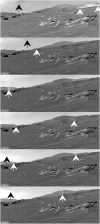Dust, Sand, and Winds Within an Active Martian Storm in Jezero Crater
- PMID: 36245893
- PMCID: PMC9540647
- DOI: 10.1029/2022GL100126
Dust, Sand, and Winds Within an Active Martian Storm in Jezero Crater
Abstract
Rovers and landers on Mars have experienced local, regional, and planetary-scale dust storms. However, in situ documentation of active lifting within storms has remained elusive. Over 5-11 January 2022 (LS 153°-156°), a dust storm passed over the Perseverance rover site. Peak visible optical depth was ∼2, and visibility across the crater was briefly reduced. Pressure amplitudes and temperatures responded to the storm. Winds up to 20 m s-1 rotated around the site before the wind sensor was damaged. The rover imaged 21 dust-lifting events-gusts and dust devils-in one 25-min period, and at least three events mobilized sediment near the rover. Rover tracks and drill cuttings were extensively modified, and debris was moved onto the rover deck. Migration of small ripples was seen, but there was no large-scale change in undisturbed areas. This work presents an overview of observations and initial results from the study of the storm.
© 2022. The Authors.
Conflict of interest statement
The authors declare no conflicts of interest relevant to this study.
Figures




References
-
- Battalio, M. , Szunyogh, I. , & Lemmon, M. (2016). Energetics of the Martian atmosphere using the MACDA data set. Icarus, 276, 1–20. 10.1016/j.icarus.2016.04.028 - DOI
-
- Bell, J. F., III , Maki, J. N. , Mehall, G. L. , Ravine, M. A. , Caplinger, M. A. , Bailey, Z. J. , et al. (2021). The Mars 2020 perseverance rover mast camera zoom (Mastcam‐Z) multispectral, stereoscopic imaging investigation. Space Science Reviews, 217, 24. 10.1007/s11214-020-00755-x - DOI - PMC - PubMed
-
- Bell, J. F. , & Maki, J. M. (2021). Mars 2020 mast camera zoom bundle, from Arizona State University Mastcam‐Z instrument team, calibrated products. PDS Imaging Node. 10.17189/q3ts-c749 - DOI
-
- Cantor, B. A. , James, P. B. , Caplinger, M. , & Wolff, M. J. (2001). Martian dust storms: 1999 Mars orbiter camera observations. Journal of Geophysical Research, 106(E10), 23653–23687. 10.1029/2000JE001310 - DOI
LinkOut - more resources
Full Text Sources
Miscellaneous
